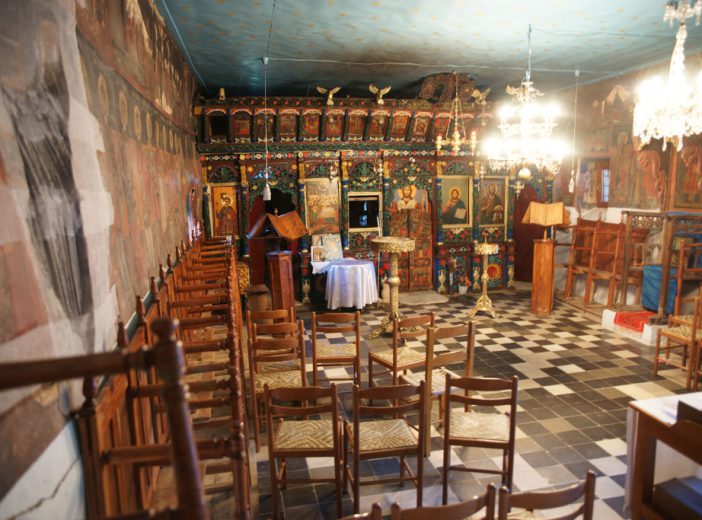The Church dedicated to the Assumption of the Virgin (Koimisi Theotokou) dates back to the era of the Ottoman occupation, when the Greek people lived under conditions of enslavement and terror. The Ottomans did not permit the building of churches, nor the operation of Greek schools. The Greeks did what they could in secret, and created the clandestine schools [kryfo scholio].
The Aga of Fanari was bribed by the notables of Kerasia, and he gave them permission to build a semi-underground church, in order to house the miraculous Holy Icon that came from Lasda of Kanalia and lay upon the walnut tree.
There is no date of construction; it is lost in the black annals of bitter enslavement. A plaque cites 1770, but this refers to the latter church.
At the root of the walnut tree where the holy icon lay, a spring emerged with miraculous holy water – the faithful would drink or bathe in it and be healed. The spring run dry when a Turkish woman, the wife of an officer, bathed in it. Afterwards, the faithful would take wet soil in commemoration of their visit and be healed.
At Panagia, there was a flourishing convent with many nuns, who lived off of the convent’s large estate: land, stock, bees, and contributions.
The church of the Virgin Mary [Panagia] housed the clandestine school, where lessons were taught by the following:
- Stergios Papas, from Kerasia, son of Papagiannis
- Konstantinos Saridas, from Ioannina
- Vaios Dimitriou, who wrote in the church’s rubric book: “And the priest is Konstantinos and he has reached the ripe old age of 66 years – 1876. Signed: Vaios Dimitriou, educator, Kerasia“. In the original spelling of the phrase there are two errors.
- Elsewhere in the same book there is a hand-written illegible text, signed “Siadas Christos”.
- Pelekanos. He taught Konstantinos B. Zarkadas, the renowned Papandoulas, Giannos Zarkadas, Konstantinos Lambrou Miaritis, and others, reading from the gospels and psalms, for there were no other books available, and writing on the “pinakidia”.
The “pinakidia” were shallow rectangular crates, the size of a school book, 2 centimeters deep. In these, the wealthy children had beeswax, while the poor ones had “clay” – mud made of soil. On these they wrote with the grafida [stylus], made of dogwood rods the size of a modern-day pencil; it was pointed on one end and flat on the other, the size of a thumbnail. What they wrote with the pointed end, they erased with the flat. The beeswax pinakidia needed no special care, but the clay ones had to be covered with a wet rag at night, so that the clay wouldn’t dry out.
- Karatzanis from Vounista, who beat the students less than the others, who beat them savagely.
After 1881, there came:
- Missas from Karitsa, and subsequently the following, from Kerasia:
- Evaggelos Mores
- Matthaios Alexopoulos
- Georgios Zarkadas (Papagiorgis)
- Papandoulas Zarkadas








